2020-2021 Fritschi Xenic 10
Test Locations: Chugach & Kenai Mountains, Alaska
Days Tested: 6
Release Value Range: 4-10
Available Brake Widths: 85, 95, 105 mm
Available Crampon Widths: 85, 95, 105 mm
Climbing Aids: Flat, 39 mm
Forward Elastic Travel: 10 mm
Heel Mounting Gap: 1 mm
BSL Adjustment: 25 mm
Stated Weight per Binding (no leash, no brake): 280 grams
Blister’s Measured Weight per Binding (no leash / no brake): 314 & 326 grams
MSRP: $429.95 USD
Boots Used: Atomic Backland Carbon, Scarpa Maestrale XT, Scarpa Alien RS, Dynafit Hoji Free
Ski Used: Black Diamond Helio 116, 186 cm
[Note: Our review was conducted on the 19/20 Xenic 10, which was not changed for 20/21.]
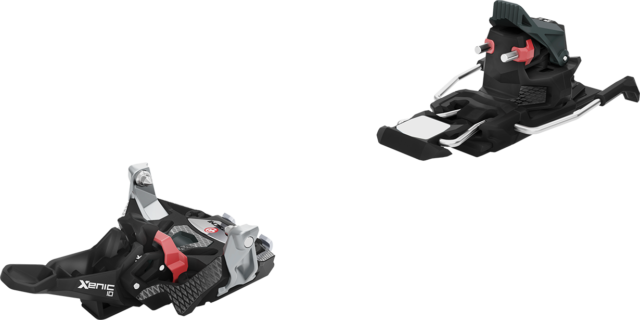
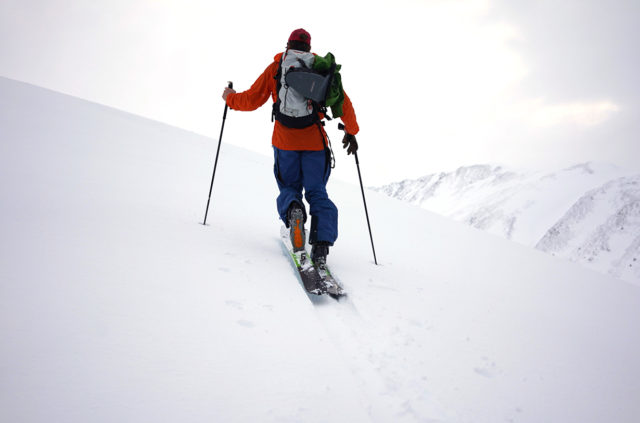
As we noted in our Lightweight Touring Binding Shootout, the category of ~250-400 g touring bindings is quite competitive at this point, with a lot of options that perform quite well on the up and the down, given how light they are.
I spent part of this past winter skiing on the Xenic here in Alaska with a variety of different boots in a variety of different conditions, so here’s my take on Fritschi’s lightweight binding.
Design — Toe Piece
At first glance, the biggest departure of the Xenic from many other bindings in this ~300 g class is its plastic construction. While there are other exceptions like the Marker Alpinist & Dynafit TLT Speed, many of the bindings in this class are primarily made of metal. Having spent many days on various versions of the (mostly plastic) Fritschi Vipec and Fritschi Tecton, the Xenic’s appearance is familiar and based on bindings with decent track records, but it looks quite different from the machined and forged parts of many of its direct competitors.
One feature that separates the Xenic from other bindings in this class is its “fixed stop and step-in pedal.” This appears to be a simplified version of the same concept on the Tecton and Vipec wherein the boot makes contact with the “step-in pedal” which engages the toe wings / jaws to snap into place. The “fixed stop” refers to the small block of plastic just in front of the toe that, when in “ski” mode, assists in opening the toe wings for improved frontal release in the case of an “over the handlebars” type fall.

I’ve heard stories of the “fixed stop” causing stride issues and even boot damage on various Vipec and Tecton versions as it prevents your boot from pivoting super far forward, but on the Xenic this seems impossible as the toe block moves freely when in “walk” mode (which is also why it doesn’t reduce the range of motion you get in the toe, contrasting the Vipec & Tecton).
One of the big differences between the Xenic’s toe piece and the vast majority of other tech / pin bindings is that the Xenic’s toe wings / jaws only move horizontally, instead of pivoting out and down. Fritschi says this design is aimed to decrease accidental pre-releases.
Design — Heel Piece
The heel of the Xenic, while it doesn’t look like many other tech bindings, is very similar in terms of functionality.
One of the biggest things that separates it from bindings like the Salomon MTN / Atomic Backland Tour, Dynafit TLT Speed, & Marker Alpinist is that the Xenic uses independent heel springs, rather than a fixed “U-spring.” The main upside with this is that you can fine-tune the release value of the heel, and U-springs have been shown to cause premature wear on the tech fittings in ski boots, which in turn has the potential to affect the release characteristics of pin bindings.
Springs aside, the Xenic’s heel functions pretty similarly to most tech bindings. The heel pivots 180° to switch between ski and climb modes, and there is a single heel riser so you get a flat touring mode and a moderately high riser.
One other notable difference with the Xenic vs. many lightweight tech bindings is that the Xenic’s heel sits on a spring-loaded track that not only gives you 25 mm of adjustment for boots with different BSLs, but also provides 10 mm of what Fritschi calls “length compensation.” Essentially, the spring-loaded heel of the Xenic functions similarly to the forward pressure settings on an alpine binding in that the heel piece of the Xenic can move along the ski when you flex and bend the ski, with the goal of reducing pre-releases that can happen when a ski is flexed with a binding that has a fixed heel. Fritschi recommends setting up the Xenic so that there’s a 1 mm gap between the heel piece and the heel of your boot, a gap that’s notably smaller than most bindings without length compensation and is likely a large factor in the Xenic’s solid downhill performance (more on that below).
The Xenic comes standard without brakes or leashes, but you can purchase Xenic brakes for $65. I opted to forgo the brakes, so I can’t comment on them here.
Mounting Pattern
I often mount my own skis and I appreciate it when binding manufacturers are consistent from year-to-year and product-to-product when it comes to their mounting hole patterns. It’s easier on shops and operations because they don’t have to buy new jigs for every new binding and it’s easier on consumers who might want to replace, warranty, or upgrade to new bindings without having to redrill their skis. In my perfect ski world, there would be two or three total hole patterns that all manufacturers would work around. But alas, I’m not in charge of the ski industry.
The Xenic story is partly good in this regard. The good part is that the heel pattern seems to be the same as the Tecton and Vipec. Unfortunately for skiers like me who want to replace an old pair of Vipecs with the new Xenic, the toe patterns are different. The hole width on one set of toe holes is still the same, so I was able to make it work by using a Vipec jig, but as far as I can tell, the Xenic does not share the same exact hole pattern with any other bindings on the market.
Uphill Performance / Transitions
The most notable thing I experienced when stepping into the Xenic each time is that the “step-in pedal” works as intended and it’s quite easy to engage when stepping in. Unfortunately, no matter what boot I used, it’s consistently been very difficult to flip up the lever to lock the toe into climb mode. I thought that it might get easier when swapping boots but I’ve now used 19/20 boot models from Scarpa, Dynafit, and Atomic and all of them were very difficult to get the lever to snap into climb mode on the Xenic in real-world winter conditions. I have to pull hard enough that I can feel the plastic flexing and often wonder if I’m going to just break the lever. So far it hasn’t broken but the process hasn’t gotten any easier as I’ve used the bindings more. Blister reviewer Sam Shaheen has also spent some time using the Xenic and he has had the same issues with the toe lever.
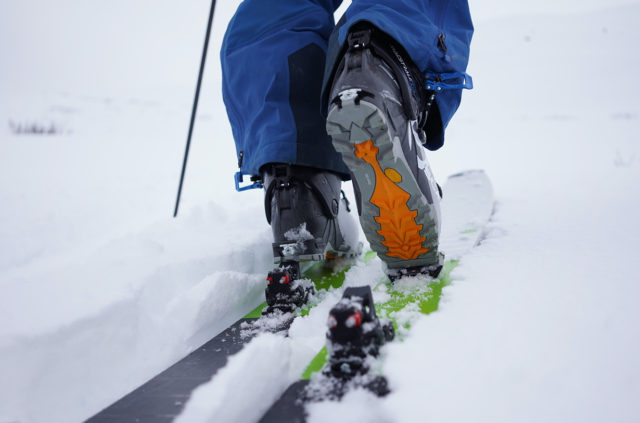
Once you have the toe lever in position, the second step to start ascending is to rotate the heel piece 180°. I’ve gotten used to rotating heel pieces but, like most bindings in this class, rotating the Xenic heel piece takes a bit of muscle. Once it’s rotated into the climb position you have two options: flat or the single riser. The riser is 44 mm off of the deck where the heel of the boot otherwise sits. At first glance, the Xenic’s riser looks pretty tall but it’s actually one millimeter lower than the Marker Alpinist’s single riser (which isn’t particularly high), once you factor in the height of the platform in “flat” mode, which is quite high on the Xenic (more on that later).
I prefer a mellow-angle skin track, and if I’m breaking trail the fairly low riser height of the Xenic or Alpinist is only an issue if the terrain constrains me into some tight or weird spot where I have to climb more steeply. When following other people’s (poorly done, in my opinion) steep skin tracks, the Xenic’s heel riser does feel low and I alternate between cursing my bindings for being low, the person who made the track for going too steep, and myself for being too lazy to make my own track.
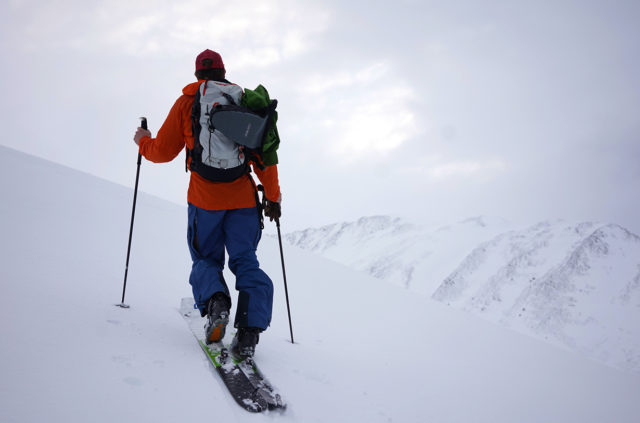
On the top of the run, I rarely remove my skis to remove my skins. Doing so decreases my chance of losing a brakeless ski, is faster, decreases the chance of ice / snow interfering with my toe pin / boot interface, and is just easier and less effort in any snow conditions once you learn to do it well. Because of this, I do fight a little with any binding that requires rotation to swap into descend mode (which is the case with most bindings in this class). It’s certainly doable with the Xenic but it’s a little awkward, especially in sketchy, exposed spots. With the Xenic, flipping the riser into the high climb position does allow for a bit more leverage and an easier transition. For reference, I’d say the Xenic is comparable in turning difficulty to the Marker Alpinist, harder to turn than the Dynafit Superlite 2.0, and much easier to turn than the Black Diamond Helio 145.
Transition Problem
The last time I used the Xenic was a cold day with light, dry snow. After a long ascent that involved removing skis a few times to boot up tricky sections, I clicked in at the top and rotated the heels to descend a fairly big run. My boot heels wouldn’t engage when I tried to step into the binding heel pieces and it was very disconcerting to see that the heel piece had slid back on its elastic travel or “length compensation” to the point where the pins were too far back to engage with my boot. I tried warming the bindings and tried tapping them to remove any ice or unstick the heel piece but I couldn’t get the heel springs to pull the binding forward into the proper position. I finally resorted to using a screwdriver to adjust the binding position forward one centimeter and was able to click in. I worried that I might break the binding on the way down because I had eliminated the elastic travel, but they seemed to fare okay. Once I was home I brought them inside and after warming up, the heel piece slid back into position and I then re-adjusted them back to where they’d been so my boots fit properly again.
I haven’t used them since then for fear of repeating the issue. I had used the Xenic multiple days prior to that in equally cold conditions with no issues, although on one other occasion I noticed the gap between the boot heel and binding was bigger than it should have been. It seems to me that the heel piece experienced some kind of icing while climbing and froze into the rearward position where it must have moved back to while climbing the steep slope.
This is not an issue we’ve experienced with other bindings in this class and there’s a chance it could be a fluke with the Xenic, but it is disconcerting.
Downhill Performance
Aside from the heel issue mentioned above, the Xenic has felt good in descend mode, especially for how light it is. Except in rare circumstances, I always ski my bindings as designed with the toe piece in the proper “ski” mode (rather than locking out the toe in “climb” mode). I have had my share of toe-piece pre-releases but had no issues with the Xenic in this regard. The heel piece elasticity does work (except when it didn’t, as discussed above) and it smooths out the ride similar to the Marker Alpinist, perhaps even slightly more than the Alpinist, which, in that particular regard, was the best binding we used in our Lightweight Touring Binding Shootout.
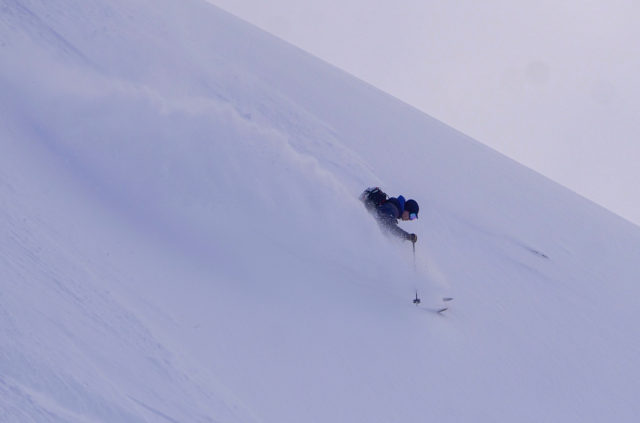
I skied the Xenic with the heel release value set at 10 at all times and never came out of the bindings. Fortunately, I didn’t experience any big crashes while using these but had my share of skiing too fast / out of control moments while using stiff boots (Dynafit Hoji Free) and the reasonably large 186 cm Black Diamond Helio 116 and never popped out of the Xenic. I suspect at least one of those moments would have resulted in a pre-release in my old Dynafit Radical FT’s.
The main downside, for me anyway, to the Xenic is it has a fairly large difference between toe and heel height, creating an above-average binding ramp angle. The Xenic’s toe pins are 32 mm off of the ski and the heel pins are 45 mm of the ski, equating to a 12 mm difference. Compare that to the Marker Alpinist, which is 34 mm at the toe and 36 mm at the pins, and especially for those with a shorter BSL, that’s a pretty big difference in ramp angle.

I won’t say that I immediately noticed the Xenic’s ramp angle and I’m pretty sure I’ve skied many years on bindings with much more radical ramp angles (looking at you Dynafit Vertical and Radical), but when going back and forth between the Alpinist and Xenic I could feel it and I prefer the lower ramp angle of the Alpinist. Some skiers might prefer the higher ramp angle as it’s something that does come down to personal preference, but it’s worth knowing what you’re getting.
Safety / Release
In theory, the toe block mechanism of Fritschi’s tech bindings should make any forward release more reliable and safer than on bindings that don’t have it. As I mentioned above, I haven’t taken any big crashes on these to test that theory. I’m sure there are certain falls for certain people where there is an advantage with this toe design, but my experience with a plethora of tech bindings is that if I crash hard enough for my heels to come loose (and my toes aren’t locked into “climb” position), the toes usually pop loose without too much trouble and this would be the situation where the toe block release would function.
The Xenic does not offer the adjustable lateral toe release that is a feature of the Tecton and Vipec series of bindings, but it does still feature fine adjustment for release at the heel and its lack of a U-spring may make it more reliable in the long run compared to U-spring bindings.
Durability
The final issue I had with the Xenic is that the “Toe-Block” on one of the bindings broke off the toe piece. I have no idea when this happened but I came back from touring one day and when I was putting my skis away I noticed that a part was missing. It hasn’t significantly affected the function as far as I can tell, except for eliminating the possibility of the forward release that I discussed above. Black Diamond / Fritschi said this would be covered under warranty.
Who’s It For?
Given the many good options in this category, it’s tricky for me to recommend the Xenic based on my experience with it so far. With a competitive weight, good downhill skiing performance, and a few novel features like the “step-in pedal,” it has a lot of potential to be a good option in the increasingly competitive and capable 250-350 g binding class. Unfortunately, my pair had some durability and functional issues that made me quit using them partway through the winter.
Bottom Line
The Fritschi Xenic has a lot of potential to be a lightweight binding that skis and tours well. Unfortunately, I had multiple issues with my pair, making it hard to recommend at this point. We are eager to see if Fritschi is able to make some updates and address those issues, as the Xenic could be a very competitive option in this class.

I demoed a ski with the Xenics mounted for 4 days of touring in Utah and I had the same functional issues mentioned in the review. The toe lock is really stiff. I like to have the option to make on ski transitions using my ski pole and I could not adjust the toe from walk to ski with my pole, let alone without all the force of my hand. the heel piece is also not capable of pole transitions. The last day I actually broke a piece off the toe trying to unlock my toe with my hand only. Its skied fine but I would not recommend. Also, no shop techs at the store I demoed skied on the Xenics on their personal gear. I’ve also skied the Dynafit speed radical and Salomon MTN bindings which I both found durable and easy to use. They are far superior.
On my pair of Xenics the lock-out-levers are hard to pull as well if there is anything in the jaws. From what I can gather, it looks like the levers are grabbing the bit that says “ski” just a bit too much (so you end up trying to pull the lever and the “ski” bit away from the ski surface together). I found if you stick your thumb through the hole in the lock-out-levers and use it to press down on the “ski” bit while pulling up on the levers, they lock-out with a normal amount of force. Warning: depending on size and strength of you thumb, this sometimes hurts — wear gloves.
I think Lou Dawson has it right: Don’t buy any tech binding in its first year.
The one exception I would make is for mostly-existing designs like the ATK R12. In that case the heel and toe mechanics are the same as the Raider 12, and the differences are mostly limited to the brake and the optional plate/AFD.
I had the same issues with the lock levers. I applied some silicone oil at the front piece and after that they both finally worked fine after using them 10x.
Over the summer I got new lock out levers sent to me from the retailer that sold me the bindings. I just installed them today, and (in the shop at least) they now seem to work normally — they are no longer hard to pull when my boot is in the binding. Hopefully any new bindings bought this season will have the newer levers.
Visually, the levers are identical, but there must be some tiny change in tolerance somewhere because they work WAY better. In case it helps anyone, bag says: Fritschi Art.-Nr.: 003921, “Easy Switch Toe Set”. Each bag only contains one, so I’d think you need to order two even though its labelled a ‘set’. (Though in small print it also says “Inhalt: 1 x 003786 Easy Switch Toe bedruckt”, so maybe you get two bags when you order 003921? I don’t know. Each bag was labelled identically.)
My lock lever works fine except when there is a little snow or ice in the binding holes on the boot. If you step into the binding and rock your foot back and forth like you skinning then lock them they seem to work fine. I think that helps the pins to seat into the pins.
I’ve had several issues with these bindings. Very difficult to lock. And then was unable to unlock and broke toe lever trying to get ski off. Both issues resolved with replacement toe piece but as you can imagine it was a nightmare when it happened. 2 Pre-releases – both times in deep snow set on 9. The heel piece was rotated when I found the skis (2nd time required a 200m down climb ). In ski mode brakes lock and don’t release properly when removing boot. Also found the delta worse than on any binding I’ve used. Even with a 6mm shim it is an effort to keep centred. Not recommended…
Hi, thanks for the review. I had very similar bad experiences with my bindings. In the slightly colder temperatures (even around 0 deg) it was impossible to lock the ski/walk switch, it actually broke once and I asked the retailer for the replacement. After the replacement I am still not sure if it even works, because I lost my ski few times going up. In the slightly snowy conditions it is very difficult to rotate the heel part back to “ski” position. I also had the stoppers, which NEVER worked – sometimes triggered when going up with the higher heel on, and NEVER triggered when the ski actually detached (no matter the ski/walk mode). I do not recommend.
Hello all. Interesting to read that it is not only me that have had problems with the Xenic bindings. I have struggled both with very stiff toe lock lever (Almost broke them too) and stoppers hanging in skiing position when I take off my skis. This happened when the temperature was below about minus 5-7 degreees Celcius. (Fortunately I did not fall and loose my skis.) When I used crampons, one of the hooks broke. A plastic piece, governing the stopper position I think, also broke on both rear bindings.
The ski shop has been very helpful though and shifted most parts of the bindings, twice, without cost. I was told that there has been production problems, wrong tolerances and other things, that have caused these problems. The broken plastic piece on the rear bindings can be due to “misuse”. The stopper shall not be hold in skiing position when turning the binding, like one does with a TLT Radical, and which I sometimes did. The guy at the shop said that the binding should not break anyway, and that three other skiers here in Norway have had the same problem. This winter, the bindings have been working properly, so far… So if you get upgraded parts there is a good chance that your bindings will work as they are intended to do. Happy skiing!
I bought my xenics last year and had the same toe lever problem everyone writes about. The solution is astonishingly simple. From what I observed, the lever works fine without the boot in the jaws. That means it works fine, when the jaws are fully closed. With the boot in, they should be fully closed unless there’s some ice or snow in the insert holes – and there usually is. Moving the boot in the jaws a few times in a walking like mode gets it removed. Then the lever works, yes, with a little resistance, but two fingers is enough to pull it.
In reference to this: “One of the big differences between the Xenic’s toe piece and the vast majority of other tech / pin bindings is that the Xenic’s toe wings / jaws only move horizontally, instead of pivoting out and down. Fritschi says this design is aimed to decrease accidental pre-releases.”
And based on what Fritschi writes on their website, it kind of sounds like they are trying to say the Xenic has some kind of horizontal elastic travel in the toe, like the Tecton and Vipec do. Is this the case? Do you have any information on how much this is? Is it really a significant amount or just some marketing talk to sound safer?
Anyone have experience with the most recent release of this binding, 22/23 season?
I’m changing over a ski with Tectons from 50/50 to 100% touring duty, and looked at xenic for being able to use (mostly) the same hole pattern.
Should I just fill the holes and go with something else?
+1 to Tim’s question!
And with respect to “(mostly) the same hole pattern”: Which of the toe piece holes can be reused, and how does it reposition the mounting point / pins?
Many thanks in advance for some answers!
I have been using Xenic 10s for the past few seasons on a couple different skis. I have not had any of the above issues. Started using them around 2023, so hopefully they have worked out the kinks.